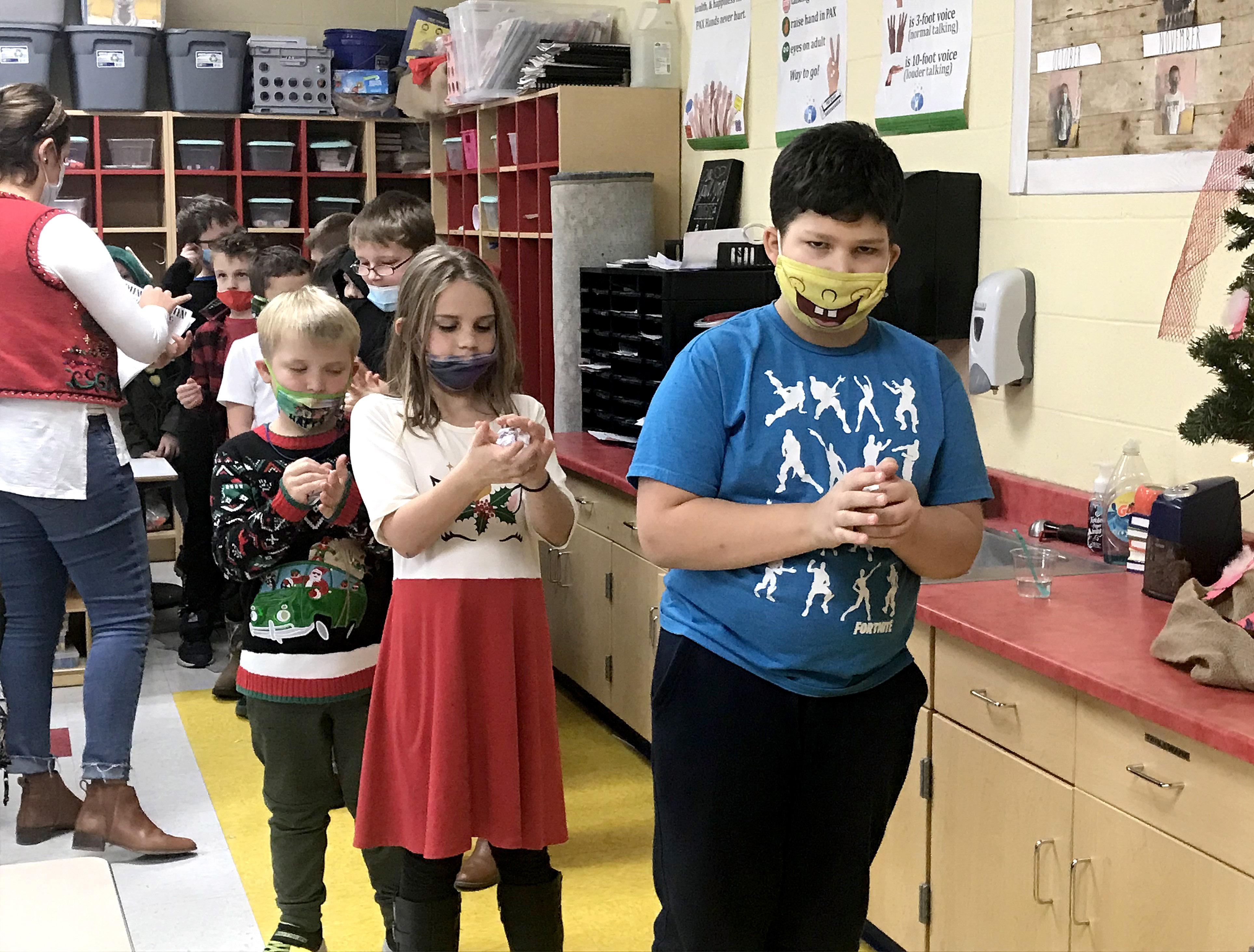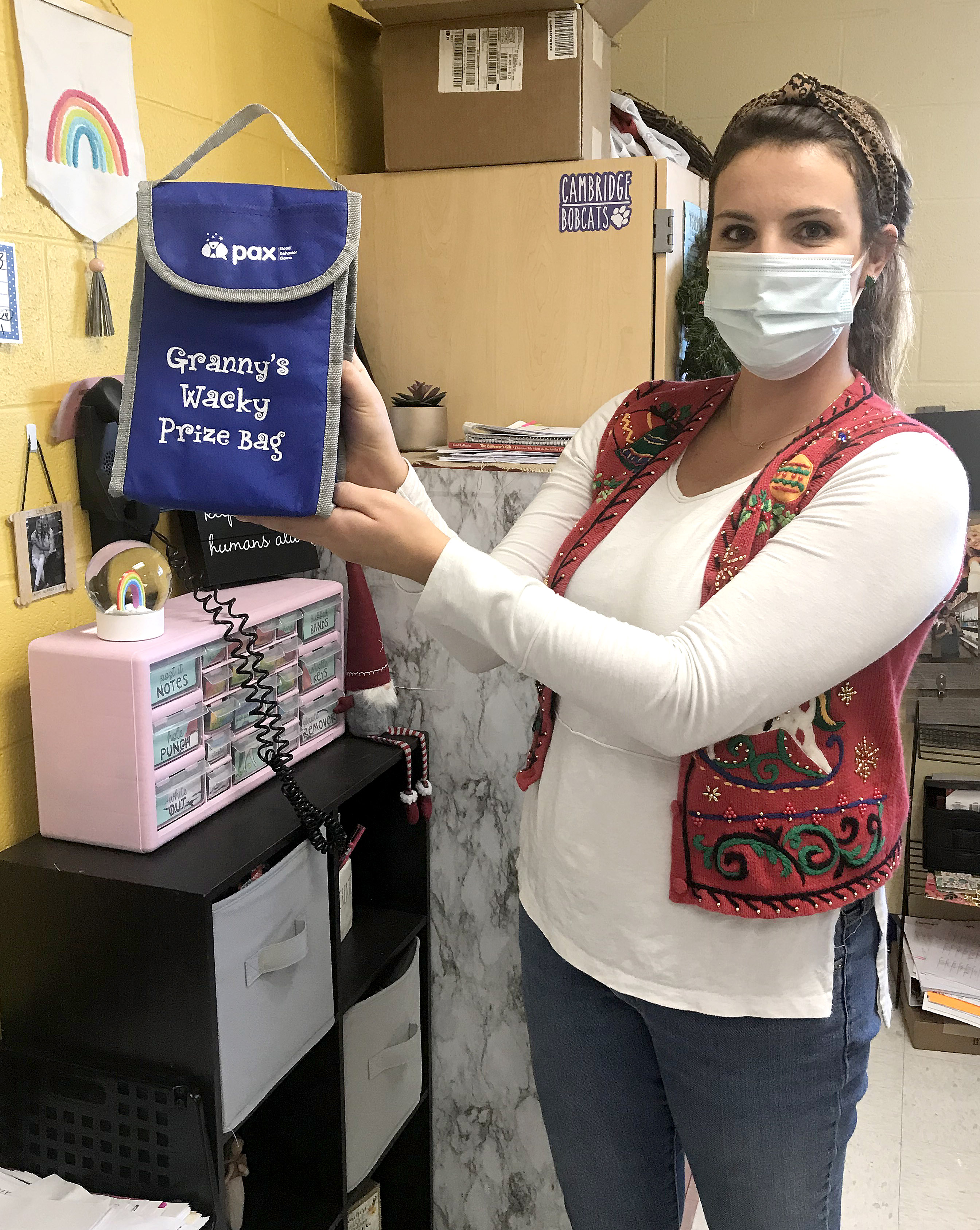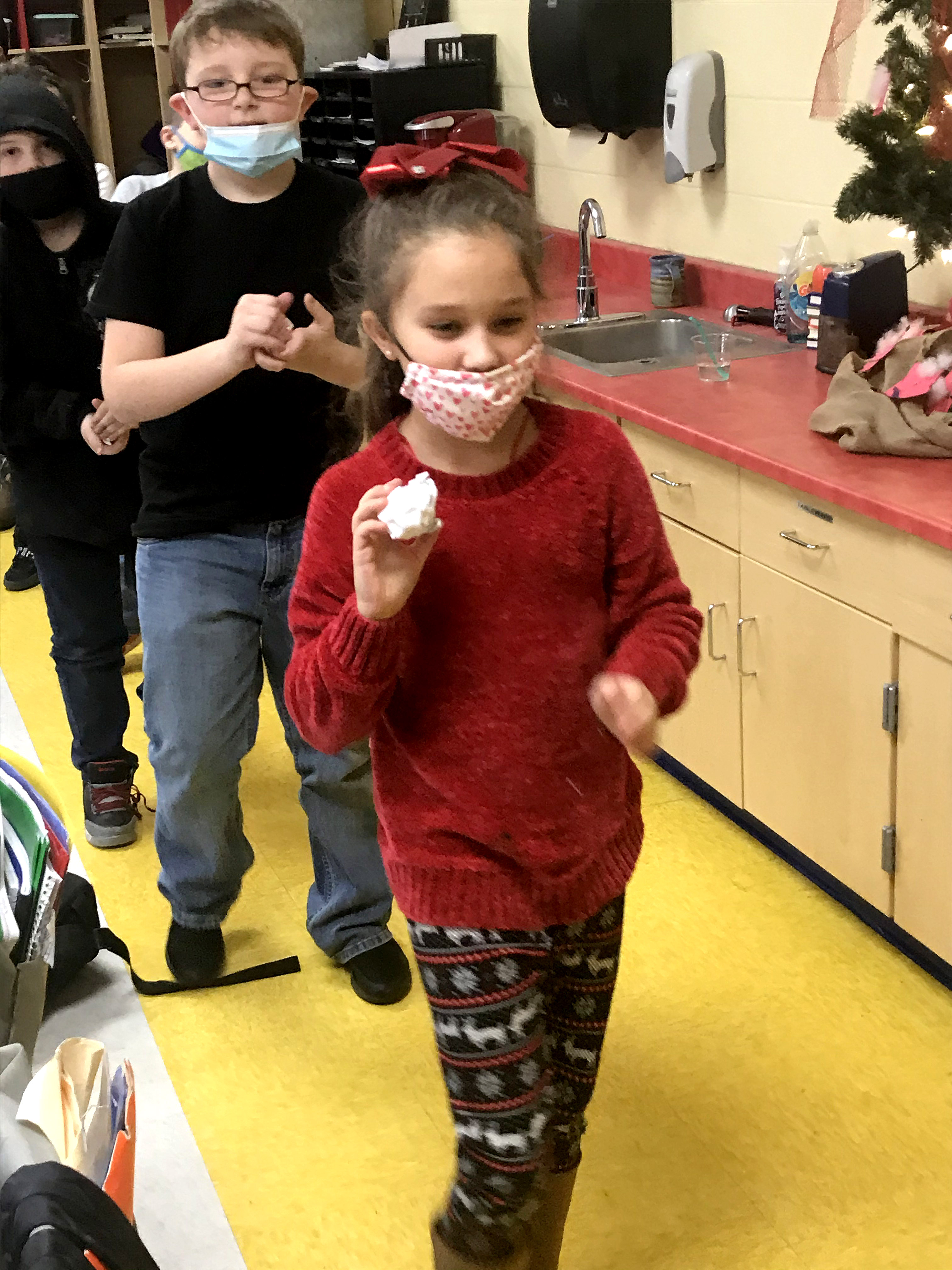In today’s world of extreme partisan politics, a world-wide health pandemic and a glut of negativity, some positive reinforcement and dose of kindness can make a significant difference.
This concept has been implemented with much success in schools across the country and is now seeing success in Cambridge City Schools. It’s called the PAX Good Behavior Game.
To those not yet indoctrinated, words like “spleems” and “tootles” may make you think you’re listening to an alien language. And for some, the concept is as foreign as a walk on Mars.

The technical description from the PAXIS Institute defines the PAX Good Behavior Game as a universal preventive intervention used by teachers and schools to teach self-regulation, self-management, and self-control in young people.
In layman’s terms, the game is way to encourage good behavior in and out of the classroom by focusing attention on good behaviors.
Most teachers find that implementing the game in their classroom and in the school improves the behavior of the students and allows them to spend more time teaching academics.
More importantly, the game has a positive impact on students. They tend to be kinder, more supportive, and more encouraging to their classmates and more respectful to their teachers and other adults.
According to the PAXIS Institute, research has shown that playing the PAX Good Behavior Game radically improves outcomes in schools including:
• Decreases in identification for special education services
• Decreases in office referrals and school-related violence
• Increases in reading scores
• Increases in standardized test scores in reading and mathematics
Statistics also indicate that students who learn the PAX Good Behavior Game are less likely to use drugs or alcohol or get into legal trouble.
The PAX Good Behavior Game also helps teachers.
“Young teachers often struggle with behavior management,” Jennifer Coulter, a third-grade teacher, offered. “I struggled with that because I wasn’t confident. The PAX Good Behavior Game gave me guidelines and the help I needed.”
Cambridge Schools Find PAX
The PAX Good Behavior Game was brought to Cambridge by Intermediate School principal Laurie Goggin and has grown in popularity during the past few years.
“I found out about PAX from a teacher friend in the Talawanda School District who had just been through the training and knew that it would be something I would be interested in learning about,” Goggin said. “As a staff, we had been looking for something that we, as a group, could use. We wanted something so that we were all using the same vocabulary, having similar expectations, and producing positive outcomes.
“I started researching it and then had the opportunity to meet with some folks from Coshocton who had brought PAX into their system,” Goggin continued. “We discussed the trainings that were needed, how the staff and students viewed the vision, and what outcomes were being seen.”

Shortly thereafter, the decision was made to use the PAX Good Behavior Game in the district. A grant from the Mental Health and Recovery Services Board (MHRS) paid for the first level training of all of the Pre-K through fifth grade teachers in Cambridge. In addition, MHRS funded internal PAX Partners training, PAX Heroes training and PAX Community Partners training.
“I don’t know where we would be without the support of the Mental Health and Recovery Services Board,” Goggin said. “They have provided an incredible amount of support. I don’t know if we would be able to implement the PAX Good Behavior Game in our school district if were not for their support.
External Partner Brought Onboard
Last year, in cooperation with AllWell Behavioral Health, the school district hired a PAX external partner, Jordan Wooten, to help develop the program at the Intermediate and Primary schools. Wooten’s position is funded in part by Allwell Behavioral Health, Nationwide Children’s Hospital and the MHRS Board of Zanesville.
“Because of a grant from the State of Ohio and Children's Nationwide in Columbus, we have had the opportunity to work with an outside PAX partner,” Goggin said. “Jordan's role is to help us develop our PAX Program further by developing our own in-house teams, modeling the various kernels and working with us to develop a level of sustainability within our staff to maintain a strong PAX program.”
A strong PAX program means students feeling good about themselves.
“PAX is not a discipline program and it is not a class management program, although it can be beneficial in both of those areas,” Wooten said. “It is a strategy to increase positivity. We want kids to feel positive about themselves.”
How does it work?
Each classroom starts the school year by creating a PAX Vision. Teachers and students decide together what they want to see, hear, feel, and do more of, and what they want to see, hear feel and do less of.
“It is extremely important for the kids to be involved in creating the vision,” Wooten said. “We want the kids to have the voice. We encourage the teachers to guide them, but we do not want teachers to decide what goes on the vision by themselves.”
Third grade teacher Jodi McGuire agrees.
“If the students come up with the ideas for the vision, they are more likely to believe it and follow it,” McGuire said. “It sets up expectations; not only what teachers want, but what the students expect from each other.”
While PAX behaviors are encouraged at all the times, during the PAX Good Behavior Game, teachers watch the student’s behavior more closely. The game might be played for a minute or can extend to 45 minutes. Students may be divided into teams or may participate as a group.
The idea of the PAX Good Behavior game is to get through the predetermined time period with a minimum number of “spleems.” Spleems are behaviors the teachers and students want to see less of. The goal for a Good Behavior Game is to have three spleems or less. If a team or group has three spleems or less, they receive a reward.
Students are rewarded with a Granny Wacky Prize which is a short activity that encourages students to have a little fun. The prizes are pulled from a bag of Granny’s Wacky prizes or selected from the PAX app and can be something as simple as doing jumping jacks beside your desk.
Wooten explains that spleems are usually earned for inattentive behaviors like looking off into space, constantly getting up and moving, or fidgeting with an object that may cause a distraction to other students.
“The idea is to draw down inattentive behaviors and create more instruction time for teachers,” Wooten said.
“I like to incorporate the game into difficult times in the day, like the end of the day and other transition times,” Coulter said. “It is also helpful during academic times.”

“I incorporate a lot of cooperative learning into my daily lessons, so PAX goes hand-in-hand and just makes sense to use in the classroom,” McGuire added. “I'm not only teaching content for the subject area, but also social skills that they need in their daily lives to build positive, healthy relationships.”
Other PAX kernels that are implemented are PAX Quiet where a teacher or student holds up the peace sign with their fingers. A teacher blows a harmonica – which is a more peaceful sound than a whistle – and the kids will get quiet and bring their attention to the teacher because it’s time to move on or the teacher has a direction to give.
PAX Sticks – popsicle sticks with student’s names on them -- are pulled from a jar to call on students to answer questions or sign up for classroom jobs, etc.
“Using the PAX Sticks gives the students a feeling of fairness that one student isn’t always getting called on,” Wooten said. “It also lowers anxiety for students.”
PAX Hands and Feet is a way to talk about what a student should be doing with their hands at certain times. For example, when walking down the hallway, hands should be at the student’s side and not touching the walls or other students.
Other kernels include PAX Voices, Beat the Timer, and PAX Okay/Not Okay. All PAX kernels lead to the Good Behavior Game.
After students complete the PAX Good Behavior Game, they spend a few minutes reflecting on the game by talking about how they did.
“We want them to talk about things they did well and things they can do better,” Wooten said. “And because the PAX Vision is a living document, the students can decide to add to the vision or take things off the vision that they have been doing well.”
The reflection time encourages students to self-regulate which helps teachers with time management and provides time for the positive reinforcement.
Tootles
Another way students receive positive reinforcement in the PAX Good Behavior Game is with tootles.
A tootle is a positive note that lets a recipient know that someone noticed their good behavior.
“It tells them that they did a great job and that we are proud of them,” Wooten said. “It is something that goes with them that they can have forever. Maybe someday when they are having a bad day, they can pull out their tootles and feel better about themselves.”
Tootles are often given by teachers to students but can also be given by students to other students, by students to teachers, and by students to their parents. In fact, Cambridge students recently made tootles to be distributed to first responders in our community.
PAX Leaders
While there are a number of benefits to the PAX Good Behavior Game, the biggest is that students learn to be PAX Leaders.
PAX Leaders are not elected by classmates or appointed by the teacher, any and every student is a PAX Leader.
“All of our kids are PAX Leaders,” Wooten said. “We want our students to see themselves as PAX Leaders. Maybe they see themselves as PAX Leader because they helped a friend, or helped a teammate win the game, or helped the teacher, or helped a brother or sister or somebody in the community.”
We Are PAX
If the PAX Good Behavior Game works, it permeates everything the student does in and out of school. Parents are encouraged to implement PAX at home. In fact, Wooten and Goggin do trainings with parents, guardians, and community members, called PAX Tools, so they can learn how to implement PAX strategies at home.
McGuire points out that the PAX Game reflection often includes asking the students how they were a PAX leader at home.
“I think there is a carryover to home. We are building a sense of PAX, a community of PAX,” McGuire said.
“You can hear the kids reinforcing each other’s positive behaviors and they are more empathetic and supportive of each other,” Coulter agreed. “My students came to me and asked if they could send tootles to each other.”
Both teachers share examples of seeing students implementing kernels from the PAX Good Behavior Game outside of the classroom as well.
“PAX may begin as a program in our schools, but the goal is that it becomes a way of life,” Goggin said. “PAX equals peace, productivity, health and happiness; those are basics for living. They are objectives that we all hope for and work towards. The goal as we move through school is that we don't just DO PAX but that WE ARE PAX.”
Most would agree, the world could use more PAX Leaders.